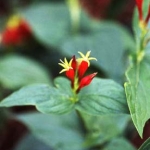| Common Name: |
Pinkroot |
| Other Names: |
Worm Grass |
| Genus |
Spigelia |
| Botanical Name: |
Spigelia marilandica |
| Family: |
Loganiaceae |
| Native Location: |
Southeast N America (Maryland to Texas) |
| Cultivation |
Rich, moist, well-drained soil in shade or partial shade. |
| Propagation |
By seed sown in autumn or spring; by division in spring. |
| Harvest |
Leaves are picked as required and whole plants are cut when in full bloom, and dried for infusions. Roots are collected in the autumn and dried for decoctions. |
| Height: |
60cm (24in) |
| Width: |
60cm (24in) |
| Hardiness |
Z2-8 |
| Parts Used: |
Leaves, whole plant, roots |
| Properties |
A pungent, bitter-sweet, irritant herb that destroys intestinal parasites. In small doses it improves digestion and lower fever. |
| Medicinal Uses: |
Internally for fevers, malaria and poor digestion (leaves, whole plant). Taken in conjuction with laxative herbs, such as Senna alexandrina (See, Alexandrian Senna), to expel tapeworms and roundworms (root). |
| Warning: |
Excess causes vomiting, spasms, and convulsions, and may prove fatal.
For use by qualified practioners only. |
| Bibliography: |
Encyclopedia of Herbs by Deni Bown Copyright © 1995, 2001 Dorling Kindersley Limited. pg 373 |
